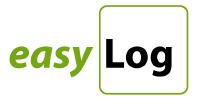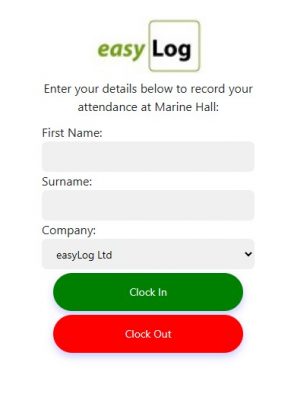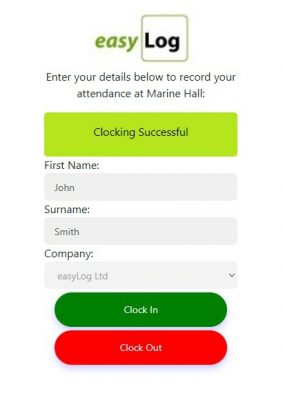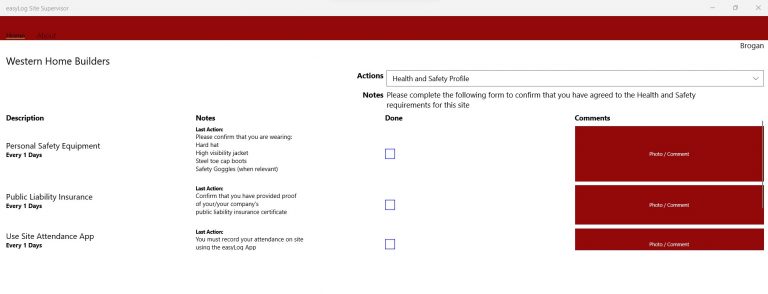
Flexible reports for easier timesheet management
When you’re choosing a staff attendance system it’s easy to focus more attention on the employee-facing technology than what’s going on under the bonnet of the supporting software. But at easyLog we put a great deal of thought and effort into ensuring the behind-the-scenes features of our attendance products are as practical, simple to use and efficient as the clocking function.
Take reports, for instance. We have fine-tuned the report options to enable customers to view the data they need in ways that will help make managing timesheets, costings and pay more accurate and efficient than before. This is a taste of what you can expect.
Flexibility is the key
Being able to handle attendance data in the way that suits your particular organisation, staff and way of working is essential for effective management – so we have made the way reports are created and viewed as flexible as possible.
For instance, you can select data:
- By site
- By client
- By department
- By grade
- By employee
- By work group
- And individually, or by a range, or by all
How you choose to format the report is equally flexible:
- Timesheets can be rounded however you like – for example, to the nearest 15 minutes, or five minutes, and so on
- Deduct unpaid breaks by definable rules
- You can also view summaries and averages
Control of your costs
The “Costed” report option is another useful feature that is popular with customers, particularly those that employ sub-contractors such as construction companies. This report allows the user to define a pay rate per hour per person and then automatically add up a costed timesheet – handy for comparing against contractors’ invoices and keeping control of your costs.
The clever reports you don’t usually get
Feeback from customers shows that they appreciate the range of reports on offer. One they particularly like is the “Between first and last clockings” report. This shows the hours between the first and last clocking of the day and so gives a total timesheet for the hours on shift, without all the detail in between – which, of course, they can also see if they want. This is especially useful where workers start and end their day from one location – for example, going to an office to pick up a van and then returning it later that day.
Another report just lists who has clocked in on any selected day. And then there is the “Clients not visited” report, which enables you to check on clients or sites that have not been attended over a defined period.
Keep your accountant happy
Data reports need to be shareable with relevant parties, not least your accountancy software. So we have a range of export options, including Excel, Word, PDF and CSV, so you can make the most of the data.
Find out more
If you have any questions about our attendance solutions and reports, talk to one of our team on 01892 834406 or request a callback using the form on this page.
Need a speedy way to clock-in sub-contractors? You’ve got it.
Keeping track of the working hours of regular employees is usually pretty straightforward – it’s just a question of choosing the right easyLog attendance app to suit your team and requirements and downloading it. Simple. But when you are dealing with sub-contractors and other short-term or irregular workers, the situation is a bit more fluid.
In the construction industry especially, the personnel attending sites can change regularly and there may be a steady stream of new workers and visitors to keep track of. But going through the process of pre-registering them all on the company’s employee attendance recording system is not really practical. So easyLog has developed an ingenious workaround: the employee and sub-contractor attendance recording solution, or eLogESCAR.
Fast and reliable clocking with no pre-registering required
This simple attendance monitoring option requires just a smartphone and a free-to- download QR code. To clock in, users simply scan the QR code with their phone to open a web page and then fill in their name and company details when prompted.
The software confirms the attendance location using geolocation technology and holds their details so they can simply scan the QR code to call up the web page and press the clock out button when they leave.
Accurate timesheets and invoices backed-up by geolocation data
Because the software automatically identifies the location the person is attending, site managers can easily see who is on-site at any time. It’s quick, simple and reliable – and, best of all, no pre-registration is required.
- Ideal for sub-contractors, temporary workers and visitors
- Attendance locations are confirmed by geolocation technology for accurate timesheets
- Reporting by time and by hourly cost and by individual and sub-contractor company, helping you reconcile invoices with actual attendance
- Managers can easily see who is on-site at any time
- The software can be used to check attendance in the event of an evacuation
- Further check boxes can be added to the attendance screen if required, for example to confirm skills and plant operation certification or that health and safety guidelines have been read
Find out more about eLogESCAR
For more information about our simple, low-cost web page attendance option, talk to one of our team.
Get the best attendance app for the job

Is it really possible to have too much choice? With our ever-growing variety of employee attendance recording options, it can sometimes be hard for customers to decide which products are most suitable for their workers, site locations and specific requirements.
This guide provides answers to some of the questions we often get asked when helping customers to find the best attendance management technology for their particular job and circumstances.
Q: What would you recommend to get up and running quickly? My employees visit multiple client sites and I’m on a tight budget.
A: One of easyLog’s most popular products is our Location Clock QR code clocking app because it is so quick and easy to set up and uses employees’ own smartphones as attendance recording devices, keeping capital outlay to an absolute minimum. Staff simply download the app from the online store for their operating system and record attendance by using their phone to read a free-to-download QR code at each work location, making it ideal for workers who visit multiple sites or different areas within a single workplace. The app is easy to use, cost effective and very reliable – clockings are backed-up by geolocation coordinates and other in-built security features so attendance is recorded accurately, even if a worker tampers with the clock on their phone, for example. Plus there are no up front costs – just a small monthly charge based on the number of app users. Prices start at £18 plus VAT per month for up to 10 people and include installation, easyLog software and support.
Q: We have multiple workers attending just a couple of sites: what is the most efficient way to clock them in and out?
A: In the past, employers in this situation would almost certainly have opted for a fixed clocking terminal, with all its attendant capital and maintenance charges. Nowadays we believe a tablet offers all the benefits of a fixed terminal at a significantly lower cost. You can choose whether you want to fix the tablet in place, and let employees clock themselves in and out, or would prefer a supervisor to oversee the process. You can also select the clocking app according to the level of security you require, from simple PIN or dropdown menu selection through to foolproof photographic identification. You can even mix and match clocking apps to suit employees with different attendance recording needs, such as office staff and shop floor or contract workers.
Q: I just want a straightforward clocking in and out solution so I can manage timesheets more easily and keep track of who is in the building. What are my options?
A: We would usually advise a simple tablet-based attendance app, such as easyLog’s Clock With ID, to customers who just want a straightforward clocking solution without extra identification technology. Staff just open the app and input a pre-allocated PIN or select their name from a dropdown menu whenever they arrive or leave. The tablet can be fixed or portable and, as with all our attendance apps, the clocking data is confirmed by built-in security features such as geolocation coordinates and server logs. This app can be coupled with our visitor attendance management module, so visitors can be clocked in and out using the same dropdown menu system. We also offer a separate Roll Call app, which runs on a fire officer’s or supervisor’s smartphone or tablet and provides a live display of who is currently logged as being on your premises.
Q: I suspect some of my workers are signing in and out for each other and falsifying their hours. How can I put a stop to this?
A: All our clocking apps provide employee identification of some kind to meet the differing needs of customers. Where workers are determined to beat the system or correct identification is a matter of site safety, we would always recommend our facial recognition app, Geo Clock With Photo. This app is available in two versions, both of which provide an instant record of an employee's identity, attendance time and location, along with other built-in features that prevent clocking fraud, such as geolocation data.
Option one is full facial recognition, where biometric software automatically compares a photo taken during a clocking with a stored image and returns the result in the attendance record. Option two is image capture, where a photo of an employee is taken at a clocking and stored on a cloud server for manual checking, either at the time or later. Both versions are available for tablet or smartphone, which have their own unique identifiers. Any attempt to clock in or out on someone else’s behalf is automatically detected in the easyLog software and flagged up for action.
Q: We employ contractors so we often get people we don’t know turning up to work on-site. Do you have a simple clocking option for them that doesn’t require downloading an app on their phones?
A: Our web-based attendance solution has been developed specifically to enable employers that use short-term agency staff or sub-contractors, such as construction and events companies, to clock workers in and out quickly and easily without going through the process of setting up an app-based product. To record their attendance, workers simply open a web page by scanning a QR code with their phone, fill in their name and tap the clock in button. All that is required is a smartphone with an internet connection – the easyLog software does the rest.
Find the right clocking option for your business
If you have any questions about finding the best attendance recording app for your employees, talk to one of our team on 01892 834406 or request a callback using the form on this page.
20 years of helping customers build more efficient businesses

This year marks an important milestone for easyLog – our 20th anniversary. Since the company began trading in January 2004 following a management buy out from Feedback plc, our software range and the technology underpinning it have changed almost unrecognisably. But our philosophy has remained the same – to listen to our customers and provide them with the software products they need to manage and grow their businesses.
The journey to QR code apps and facial recognition on a tablet
Over the past two decades we have seen many changes in our industry and are proud to say that we have been at the forefront of the evolution from dedicated hardware attendance devices, such as hand-scanner clocking terminals and PDAs integrated with desk-based software, to today’s use-anywhere browser and mobile-based solutions – which have made the most sophisticated and reliable staff management products available to even the smallest organisations on the tightest budgets.
One of the most significant landmarks over the past 20 years is undoubtedly the introduction of smartphone and tablet based clocking apps back in 2013. These early apps were based on reading NFC tags but, realising that this style of clocking would be the future of employee attendance recording, we quickly progressed to developing even more versatile and low-cost yet sophisticated options using emerging technologies, such as QR codes and biometric facial recognition running on tablet and mobile devices.
Together we’ve achieved a lot
None of this would have been possible without the close working relationship we have built with our many customers, who have inspired us to innovate and helped us to refine each new software product.
To find out more about our current product range, explore our web pages or talk to one of our team.
Mix and match apps for all your staff and job management tasks

When you choose an easyLog attendance app you may think you are committing to a discrete solution to solve a specific business challenge – recording employees’ visits to a particular off-site work location, for example. But in fact you are opening the door to streamlining a wide variety of essential business functions, from everyday timesheet management to more specialised tasks, such as dealing with staff rotas and expenses, job pricing and monitoring, production line job recording and many other cost-sensitive operations.
Low-cost attendance apps that meet multiple challenges
Take employee attendance recording, for instance. Because our clocking apps use the same browser-based back-office software, two or more can be used alongside each other at different sites or even within a single location where there are workers with different attendance recording requirements.
This flexibility means that employers with larger or constantly mobile workforces can use clocking options that fulfil the individual needs of all their sites and workers, rather than settling for a less efficient one-size-fits-all solution. So office-based admin staff can clock in on a tablet, for example, while remote workers can use their smartphones to scan a QR to record their attendance on site – but all the records are managed via the same easyLog back office software.
One contract, many opportunities
The same flexibility applies across all our app products, saving our customers valuable time and subsequently money. As you might expect, easyLog’s wide range of attendance recording apps are designed to align neatly with our rota and HR software to make managing timesheets and pay even faster and more accurate. But you might not be aware that many of our apps have dual functions or can be customised with additional software modules to fulfil additional business reporting requirements.
Some of the versatile options currently in use include:
- Visitor management and roll call modules – a useful add-on to a basic staff clocking solution
- The Actions App module for monitoring tasks performed by remote workers, including optional note taking and feedback functions with photo upload
- Job recording with QR codes – this app, which doubles as a clocking device, is for anyone who wants an accurate method of monitoring time spent on a particular manufacturing process or any other procedure that is used to calculate costs
- Our Site Supervisor inspections and estimates manager – a module designed for cleaning and buildings maintenance contractors
- Night checks – this simple QR code or NFC tag option is ideal for confirming that tasks are being done by security guards, construction workers, cleaners and other unsupervised employees, including carers
- Care record management – a convenient note taking solution that provides a reliable record for inspecting authorities
Find out how to get more out of our apps
If you would like to know more about the mix and match opportunities provided by easyLog’s apps, contact our team.
Has the traditional clocking terminal had its day?
When newspapers prematurely printed his obituary, Mark Twain famously quipped that reports of his death were greatly exaggerated. Likewise, it may be a little early to announce the demise of the dedicated clocking terminal – but declining demand for traditional attendance recording devices indicates that they will soon be a thing of the past. And the reason is technology.
The ubiquitous rise of smartphones, tablets and geolocation data has made attendance recording with apps simpler, cheaper and more dependable than ever before. Clocking apps are also more flexible than a dedicated fixed terminal, offering functions and configurations to suit every location, budget and workforce. And all this without sacrificing any of the safeguards employers need to ensure accurate staff attendance recording and timesheet management.
Clocking apps: simpler, cheaper and more flexible
Whether you want a straightforward QR code clocking system for employees such as cleaners or carers who visit multiple sites, or the peace of mind that comes with a solution like facial recognition that confirms identity along with date, location and time, an easyLog clocking app can provide it – and many other options besides.
Our attendance recording apps also have the advantage that they can be mixed and matched within a single contract, so you can use one clocking format for, say, office based staff and another for remote workers. Our apps are so flexible that they can even double as job time recording, visitor attendance and roll call solutions – we have yet to see a dedicated terminal that can match that.
Reliable attendance recording without the cost
Along with their reliability and versatility, clocking apps offer exceptional value for money. Initial outlay is low because our free-to-download apps can be installed on a standard Android or Apple device, including employees’ own phones. And, unlike a dedicated terminal, a faulty tablet can be replaced at minimal cost, usually within a day – there is no waiting for expensive repairs.
Talk to us about updating your old clocking terminal
To find the right attendance app for your staff, talk to one of our team on 01892 834406, send us an email or request a callback using the form on this page.
Myth busting: 10 popular misconceptions about clocking apps debunked

Moving to phone or tablet based attendance recording can be a big change for workers and employers alike and not surprisingly raises many concerns, most of which have no basis in fact. Here we put straight some of the most common misconceptions we come across about clocking with an app.
1. My employees can cheat a clocking app by simply altering the time on their phones.
Our apps include a number of in-built features, such as cross referencing the time on the phone and identification of the phone being used, designed to prevent clocking fraud. If someone has changed the time on their phone to appear either earlier or later than they actually were, the software will detect that the clocking time does not match the time on the server and flag the discrepancy, allowing appropriate action to be taken.
2. QR codes are unreliable because someone can make a copy of the code and use it to clock in anywhere.
Any employee tempted to falsify their attendance record by scanning a QR code from somewhere other than where they are supposed to be will be found out immediately. Our clocking apps use geolocation coordinates to confirm the location of a clocking alongside the QR code location identifier, so a mismatch will be detected and flagged automatically.
3. You have to use the same attendance app or solution across all your sites.
One of the many benefits of easyLog’s clocking apps is their versatility. Two or even more app formats can be run alongside each other at different locations using the same back-office software, making them ideal for customers with multiple sites and variable attendance recording requirements. For example, an organisation with an administration centre where staff can record their attendance on a tablet but with employees that visit multiple client sites where scanning a QR code using their smartphone is the sensible low-cost option.
4. People can get someone else to clock in on their behalf when they are running late or leaving early.
All our clocking apps provide employee identification of some kind, from numeric codes to fully automatic facial recognition technology. Each mobile device also has a unique identifier. So if a member of staff tries to clock in or out for someone else, it would be automatically detected in the easyLog software and flagged up for action.
5. Staff won’t use a mobile app because they think they are being tracked.
Fears that an easyLog smartphone app could be used to track someone’s movements without their knowledge or consent are totally unfounded – and would be illegal. Our apps only identify where the user is at the exact time they make a clocking – when they scan a location QR code, for example. The rest of the time the app is inactive.
6. Clocking in and out daily with a smartphone will use up lots of data and run down the phone battery.
One clocking with our Location Clock app uses around 100-200 bytes of data, depending on variables such as the resolution of the geolocation coordinates and the length of the identification codes. This is less than a fifth of the data used to send a simple message, which takes approximately 1,000 bytes (1KB). Or, to put it another way, you would need to make between five and ten million clockings to use up 1GB of data. Similarly, our apps are only active while a clocking is made and do not run in the background, so battery requirements are minimal.
7. Using facial recognition to monitor attendance is too expensive for just a handful of staff.
One of the many attractions of using an easyLog facial recognition app on a tablet is that it puts attendance recording with proof of identity within easy reach of smaller companies on a tight budget. Unlike investing in a dedicated biometric clocking terminal, there is no initial outlay apart from a standard Android or Apple tablet, which can also be used for other business tasks. And if the tablet breaks, it can be quickly and cheaply replaced – there’s no waiting for expensive repairs. As with all our software, licence fees are charged according to the number of users. Read more about affordable clocking with facial recognition here.
8. My workers are concerned that the app will collect and store personal details about them.
All data used in easyLog software and apps is encrypted to industry standard. However, the only data held in our phone and tablet clocking apps is the user’s online ID, which is not sensitive and of no value to anyone else, and in some cases the user’s name. Pictures taken during clockings using photo ID are held on our secure servers for a maximum of three months before being deleted.
9. If there is a poor mobile signal people won’t be able to record a clocking.
If there is no network signal, easyLog’s clocking apps still allow employees to record attendance on a phone or tablet. The data is simply stored and transferred, along with the clocking time, when the next clocking is made.
10. Downloading a clocking app will interfere with other apps and take over my phone.
All easyLog’s apps have to meet the app stores’ stringent technical requirements, which include that they work in their own separate spaces and don’t stray into other applications. Permission to access additional phone features, such as the camera, location data, contacts and so on, must be granted by the user during download, as with any other app.
Find out more about easyLog clocking apps
If you have any questions about choosing the right clocking app for your workers and business, talk to one of our team on 01892 834406, send us an email or request a callback using the form on this page.
Clock and save with face recognition apps
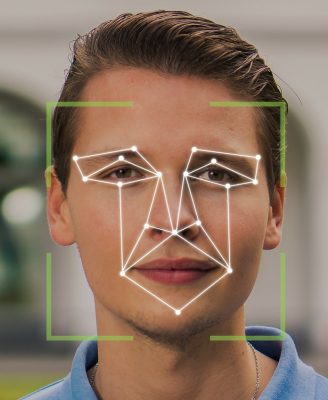
Foolproof attendance recording without the expense of a dedicated biometric terminal
In the current climate of rising prices and falling value for money, it is good to know that at least one business essential is actually becoming more affordable – foolproof attendance recording with facial recognition technology.
Know that staff are on-site and on time
Designed to provide certainty that your employees are on-site and on time, our Geo Clock With Photo app turns everyday tablets and smartphones into dependable clocking devices without the initial outlay and ongoing expenses associated with a dedicated biometric terminal.
The Geo Clock app can be downloaded from the main online stores directly onto a standard Android or Apple tablet or company phone – you just need to ensure that the device you want to use has a front-facing camera.
There is no other installation required – the face recognition software is held on our secure cloud servers so you can view and manage clocking records and timesheets anywhere on any device with a web browser. The software automatically checks each clocking with a stored image and combines the result with geolocation data, such as GPS coordinates, to provide a foolproof record of identity, location, date and time that is effective against clocking fraud. The process is quick, simple and, above all, reliable.
An affordable attendance record that’s effective against fraud
But the best bit is that using the Geo Clock attendance app offers the reliability of a dedicated biometric clocking terminal without many of the associated costs. Potential savings include:
- Low initial outlay – our free-to-download app turns a standard Android or Apple device into a fraud proof clocking terminal
- Versatility – tablets and phones can be used for a multitude of other business functions, unlike a dedicated biometric machine
- No expensive repairs – a faulty biometric terminal can cost £100s and take weeks to repair but a tablet can be replaced at minimal cost, usually within a day
- Flexibility – multiple tablets can be used in different locations or a single device can be moved where it is needed to keep costs down
Talk to our team about clocking with face recognition
To find out if our Geo Clock face recognition app is the right clocking option for your staff, talk to one of our team on 01892 834406, send us an email or request a callback using the form on this page.
Celebrating 50 years of the barcode – the forerunner of the QR code
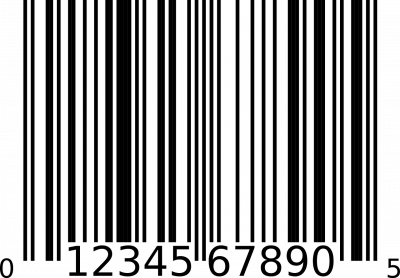
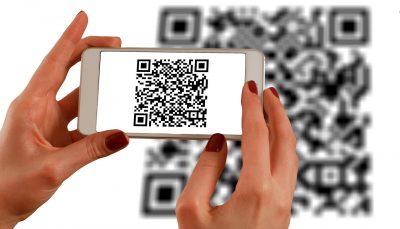
It’s thanks to supermarkets’ adoption of barcodes in the 1970s that we can record staff attendance with QR codes today
It’s hard to remember a time when barcodes weren’t absolutely everywhere – first they appeared on our groceries, then spread to books, membership cards, parcels, concert tickets and even runners’ bibs. But the barcode that we know today dates back just 50 years – to 3 April 1973.
That was when the US grocery industry adopted the first universal product code (UPC), a linear barcode developed by IBM based on an earlier concept by Norman Joseph Woodland, inspired by Morse Code. Designed to reduce costs and make stock taking easier, linear barcodes and the scanners needed to read them were gradually introduced to supermarkets in the 1970s.
From barcodes to QR codes – and recording staff attendance
QR, or quick response, codes followed soon after in 1994, invented by Japanese firm Denso Wave for tracking car parts. Their easy readability – particularly with the advent of smartphones – and greater data storage capacity meant they were quickly put to a growing range of uses, from product tracking and staff management to marketing.
easyLog’s QR code apps tap into this flexibility to create a range of low-cost and versatile management tools.
Our QR employee clocking apps, for example, use free-to-download QR codes and workers’ own smartphones or company tablets to provide simple but dependable attendance recording systems for businesses of any type and size.
We also have QR code apps that are used to time jobs on factory production lines, monitor site visits and night checks – for example in the construction, security and care industries – and even record the location of a dog sitter’s charges. In fact, we have found QR codes provide an affordable solution for almost any task where attendance at a given location needs to be recorded quickly and easily, along with any other information needed to identify, analyse and report on the work undertaken.
Find out more about our QR code apps
For more information speak to one of our team on 01892 834406 or request a callback.
Coincidentally, 3 April 1973 was not just a historic date for barcodes – it was also the day Motorola demonstrated the first handheld mobile phone.
The Actions app: When you need a reliable record that important tasks have been done
A growing number of organisations, from care providers to cleaning and maintenance contractors, have told us that they would like a simple, reliable record of tasks performed by their remote workers – for their own peace of mind, or their clients’, or both.
So we have developed the Actions module – an app for smartphones and tablets (or laptop if you prefer) designed to enable workers to record on the spot that a specific job has been completed, quickly and easily. As well as sending evidence of completed tasks automatically back to the easyLog software, the Actions app supports a number of feedback options. These include commenting on the work carried out, uploading photos of the finished job and alerting managers if further work is required.
A convenient and flexible option for remote workers
The Actions app can be used anywhere with an internet connection, so is suitable for all kinds of worker, business and location. The app software is user definable and supports multiple action lists for each location, so information can be collected about different activities within one site or many. Tasks are presented clearly and simply and can be defined with standard review periods, such as daily, weekly, monthly or six-monthly.
The app can also display images with a prompt to show users the required activity or expected end result – ideal for inexperienced or unsupervised workers.
Suitable for all kinds of employee – including carers
The Actions app can be easily customised for care providers to provide a simple but effective method of recording work as it is being done – for inspecting authorities, for example. As well as updatable care records, it can be used to provide staff with all kinds of useful information, from service users’ next of kin and GP contact details to cleaning and room changing regimes.
Find out more
And, like all our software, the Actions module can be easily tailored to suit the particular business needs of individual organisations.
For more information about tailoring the easyLog Actions app to your organisations particular business requirements, talk to one of our team on 01892 834406 or request a callback using the form on the right. You can also watch a short video on the easyLog Actions module.
Phone us now on 01892 834406 or request a callback
Browse by category
- Apple iPhone (14)
- British summertime hours (2)
- Business support (31)
- Care home management (46)
- Care record management (10)
- Care recording (11)
- Cleaning contractor software (25)
- Clocking and employee attendance (53)
- CQC Inspections (7)
- Domiciliary care and supported living (36)
- Flexible working (33)
- Holiday pay (5)
- Invoicing staff time (17)
- Latest news (38)
- Minimum wage (5)
- Mobile worker tracking (42)
- Nursing home management (27)
- Opinion (2)
- Payroll analysis (19)
- QR code and biometric clocking (24)
- Rota software (46)
- Scheduling software (44)
- Smartphone app (32)
- Time and attendance (31)
- Time off in lieu (TOIL) (1)
- Timesheets (46)
Browse our archives
- May 2024 (1)
- April 2024 (1)
- March 2024 (1)
- January 2024 (1)
- November 2023 (1)
- October 2023 (1)
- August 2023 (2)
- April 2023 (1)
- October 2022 (1)
- August 2022 (1)
- April 2022 (1)
- February 2022 (1)
- October 2021 (1)
- July 2021 (1)
- June 2021 (1)
- March 2021 (4)
- January 2021 (1)
- August 2020 (2)
- June 2020 (1)
- May 2020 (2)
- April 2020 (2)
- March 2020 (1)
- February 2020 (1)
- October 2019 (2)
- July 2019 (2)
- February 2019 (1)
- August 2018 (2)
- May 2018 (1)
- April 2018 (1)
- September 2017 (1)
- August 2017 (1)
- June 2017 (1)
- February 2017 (1)
- October 2016 (4)
- July 2016 (2)
- June 2016 (3)
- May 2016 (1)
- April 2016 (1)
- March 2016 (3)
- February 2016 (1)
- January 2016 (3)
- November 2015 (2)
- October 2015 (1)
- September 2015 (1)
- July 2015 (2)
- June 2015 (2)
- May 2015 (4)
- April 2015 (4)
- March 2015 (4)
- February 2015 (4)
- January 2015 (3)
- December 2014 (3)
- November 2014 (1)
- September 2013 (1)
- April 2013 (3)
- January 2013 (2)
- October 2012 (1)
- July 2012 (3)
- May 2012 (1)
- April 2012 (4)
- March 2012 (2)
- January 2012 (1)
